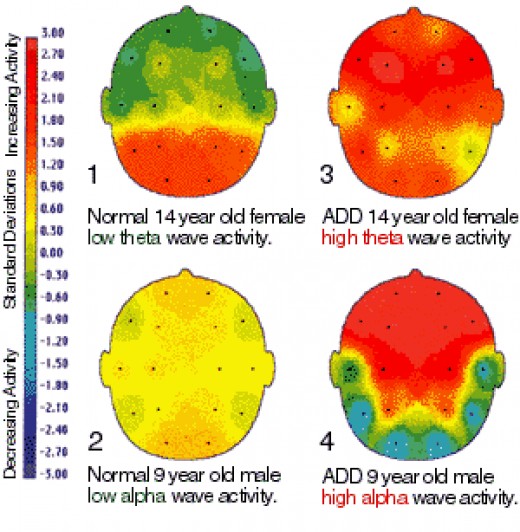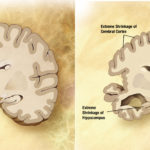ADD and ADHD are medical abbreviations, used in diagnosis and treatment of behavioral disorders in children and adults. ADHD and ADD are well-known abbreviations in the USA, UK, Ireland, Sweden, Iceland, Denmark, Netherlands, Norway, Finland, Canada, Malta and Australia.
ADD vs ADHD definitions
ADD – is an abbreviation of «attention deficit disorder» diagnosis. ADHD – is an abbreviation on «attention deficit hyperactivity disorder» diagnosis. These are interchangeable abbreviations, meaning identical diseases. Both behavioral disorders ADD and ADHD are characterized by similar symptoms that can be treated using the same medications.
In the medical literature, ADD and ADHD abbreviations are written through slash, while medical staff usually uses ADHD and ADD to describe the symptoms, signs, causes and methods of treatment of the same disorders.
ADD vs ADHD – adults and children
It should be noted that ADD (attention deficit disorder) is an archaic term, which is almost not used by doctors these days. The reason why ADD term is not popular anymore lies in its inaccuracy.
An overwhelming majority of children and adults with attention deficit disorder are overactive and excessively anxious as a rule. Therefore, the ADHD term (attention deficit hyperactivity disorder) characterizes the symptoms of this behavioral disorder more accurately.
Please note that hyperactivity is a symptom, mostly observed in childhood. Therefore, many people think of ADHD as of behavioral disorder in children in the first place.
Many people believe that ADHD (ADD) never occurs in adults. However, considering the fact that a lot of ADHD symptoms are similar to symptoms of mental disorder, adults with ADHD can be mistakenly diagnosed depression or anxiety.
Depression and ADD (ADHD) in adults and children are cured by means of different medications. Therefore, the diagnosis – is one of the key stages of treatment of behavioral disorders at any age.
ADD vs ADHD – diagnosis
The complexity of diagnosis of the behavioral disorders lies in that it has dozens of weakly pronounced signs and symptoms. Besides, ADHD (or ADD) are only diagnosed when a child or adult has several symptoms of the behavioral disorder at once.
ADD vs ADHD – differences
If a child or an adult is impulsive, inattentive and it is difficult for him to control his activity level, he is diagnosed with attention deficit hyperactivity disorder.
If a patient is inattentive, impulsive, yet is able to control his activity level, he is diagnosed with attention deficit disorder without hyperactivity.
Despite the differences between ADHD and ADD symptoms, for their treatment, doctors use the same meds. The most popular ADHD meds are sold under the trademarks Adderall, Strattera, Dexedrine, Ritalin and Concerta. You can find information on these and other meds for ADHD (ADD) treatment in the upcoming reviews.
Your child daydreams a lot at school and is easily distracted when he’s doing homework or chores. Maybe he fidgets constantly. You might wonder if he has attention-deficit/hyperactivity disorder (ADHD). Or is it attention deficient disorder (ADD)?

Is there a difference?
Many people use the terms to mean the same thing — and that’s sometimes correct. But not always.
ADD is a type of ADHD that doesn’t involve constant movement and fidgeting. But it’s a blurry distinction. The confusion dates to 1994. That’s when doctors decided all forms of attention-deficit disorder would be called “attention-deficit/hyperactivity disorder,” even if the person wasn’t hyperactive.
Which term is right for your family to use depends on your child’s specific symptoms and diagnosis. It’s important to talk with an experienced mental health provider to make sure your child gets the right diagnosis.
Daydreamer or Fidgeter?
ADHD is a brain-based disorder. It can interfere with your child’s everyday activities at home and at school. Kids who have it have trouble paying attention and controlling their behavior, and are sometimes hyperactive.
Before she’s diagnosed, you will want to note your child’s symptoms. The CDC offers an ADHD checklist for children that may help you keep track of them.
Here are the signs to look for:
- Inattention:includes disorganization, problems staying on task, constant daydreaming, and not paying attention when spoken to directly.
- Impulsivity:includes spur-of-the-moment decisions without thinking about the chance of harm or long-term effects. She acts quickly to get an immediate reward. She may regularly interrupt teachers, friends, and family.
- Hyperactivity:involves squirming, fidgeting, tapping, talking, and constant movement, especially in situations where it’s not appropriate.
Mental health professionals in the United States use the Diagnostic and Statistical Manual of Mental Disorders (DSM) to diagnose all psychiatric conditions, including ADHD. The latest version divides it into three types:
- ADHD predominantly inattentive presentation (ADD)
- ADHD predominantly hyperactive-impulsive presentation
- ADHD combined presentation
Your child’s diagnosis will depend on her specific symptoms.
Attention deficit hyperactivity disorder (ADHD) is one of the most common childhood disorders. ADHD is a broad term, and the condition can vary from person to person. There are an estimated 6.4 million diagnosed children in the United States, according to the Centers for Disease Control and Prevention.
This condition is sometimes called attention deficit disorder (ADD), but this is an outdated term. The term was once used to refer to someone who had trouble focusing but was not hyperactive. The American Psychiatric Association released the Diagnostic and Statistical Manual of Mental Disorders, Fifth Edition (DSM-5) in May 2013. The DSM-5 changed the criteria to diagnose someone with ADHD.
Keep reading to learn more about the types and symptoms of ADHD.
Types of ADHD
There are three types of ADHD:
1. Inattentive
Inattentive ADHD is what’s usually meant when someone uses the term ADD. This means a person shows enough symptoms of inattention (or easy distractibility) but isn’t hyperactive or impulsive.
2. Hyperactive/impulsive
This type occurs when a person has symptoms of hyperactivity and impulsivity but not inattention.
3. Combined
Combined ADHD is when a person has symptoms of inattention, hyperactivity, and impulsivity.
Inattention
Inattention, or trouble focusing, is one symptom of ADHD. A doctor may diagnose a child as inattentive if the child:
- is easily distracted
- is forgetful, even in daily activities
- is unable to give close attention to details in school work or other activities and makes careless mistakes
- has trouble keeping attention on tasks or activities
- ignores a speaker, even when spoken to directly
- doesn’t follow instructions
- fails to finish schoolwork or chores
- loses focus or is easily side-tracked
- has trouble with organization
- dislikes and avoids tasks that require long periods of mental effort, such as homework
- loses vital things needed for tasks and activities
Hyperactivity and impulsivity
A doctor may diagnose a child as hyperactive or impulsive if the child:
- appears to be always on the go
- talks excessively
- has severe difficulty waiting for their turn
- squirms in their seat, taps their hands or feet, or fidgets
- gets up from a seat when expected to remain seated
- runs around or climbs in inappropriate situations
- is unable to quietly play or take part in leisure activities
- blurts out an answer before someone finishes asking a question
- intrudes on and interrupts others constantly
Other symptoms
Inattention, hyperactivity, and impulsivity are important symptoms for an ADHD diagnosis. In addition, a child or adult must meet the following criteria to be diagnosed with ADHD:
- displays several symptoms before the age of 12
- has symptoms in more than one setting, such as school, at home, with friends, or during other activities
- shows clear evidence that the symptoms interfere with their functioning at school, work, or in social situations
- has symptoms that are not explained by another condition, such as mood or anxiety disorders
Adult ADHD
Adults with ADHD have typically had the disorder since childhood, but it may not be diagnosed until later in life. An evaluation usually occurs at the prompting of a peer, family member, or co-worker who observes problems at work or in relationships.
Adults can have any of the three subtypes of ADHD. Adult ADHD symptoms can differ from those of children because of the relative maturity of adults, as well as physical differences between adults and children.
Severity
The symptoms of ADHD can range from mild to severe, depending on a person’s unique physiology and environment. Some people are mildly inattentive or hyperactive when they perform a task they don’t enjoy, but they have the ability to focus on tasks they like. Others may experience more severe symptoms. These can affect school, work, and social situations.
Symptoms are often more severe in unstructured group situations than in structured situations with rewards. For example, a playground is a more unstructured group situation. A classroom may represent a structured and rewards-based environment.
Other conditions, such as depression, anxiety, or a learning disability may worsen symptoms.
Some people report that symptoms go away with age. An adult with ADHD who was hyperactive as a child may find that they’re now able to remain seated or curb some impulsivity.
ADHD Predominantly Inattentive Presentation (ADD)
Kids with this condition aren’t hyperactive. They don’t have the high energy level seen in others with ADHD. In fact, children with this form may seem shy or “in their own world.”
ADD is diagnosed if a child under age 16 has 6 or more symptoms of inattention (5 or more for older teens) for at least 6 consecutive months but no signs of hyperactivity/impulsivity.
The symptoms include:
- Trouble paying attention (easily side-tracked)
- Doesn’t like or avoids long mental tasks (such as homework)
- Trouble staying on task during school, at home, or even at play
- Disorganized and seems forgetful
- Doesn’t appear to listen when directly spoken to
- Doesn’t pay close attention to details
- Loses things often
- Makes careless mistakes
- Struggles to follow through with instructions
Children with this subtype of ADHD may go undiagnosed because the symptoms may be chalked up to daydreaming.
ADHD Predominantly Hyperactive-Impulsive Presentation
Children with this form of ADHD have tons of energy and are constantly moving in a way that causes problems. It’s diagnosed if a child under age 16 has 6 or more hyperactive/impulse symptoms for at least 6 months (5 or more for older teens). This form is more noticeable than the inattentive type.
Symptoms include:
- Blurting out answers before a question is finished
- Constantly interrupting others
- Trouble waiting his turn
- Talks too much
- Fidgeting, tapping, and squirming
- Gets up when it’s not appropriate (such as when the teacher is talking or in the middle of dinner)
- Running or climbing in inappropriate situations
- Unable to play quietly
For more information visit us our website: https://healthcaretipshub.com







No Comment! Be the first one.